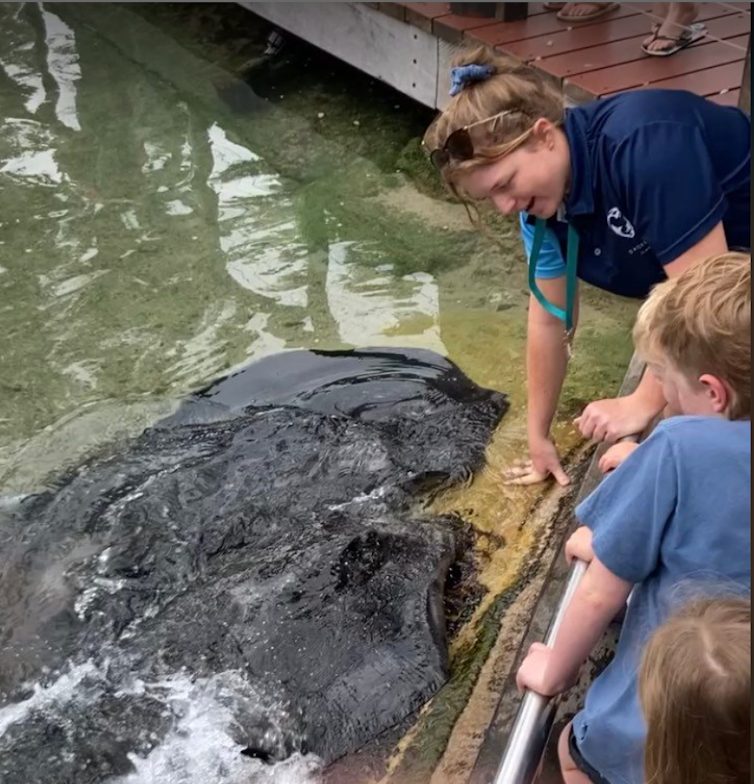
To beat the summer heat, many of us in the Southern Hemisphere are hitting the beach – and this raises our chances of encountering potentially dangerous marine life beneath the waves.
So should we be worried about stingrays? You might still think so, even if it’s been 16 years since the death of wildlife icon Steve Irwin.
Irwin wrangled some of the world’s most dangerous animals, from crocodiles to venomous snakes, yet it was a stingray that tragically took his life. When I tell others I study stingrays, they usually respond with shock, followed by a quick reminder about this. In fact, I am surprised when an Australian doesn’t mention it.
Despite their reputation as being dangerous, stingray-caused deaths are actually rare. Accidental injuries do happen, but understanding how and why “barbings” occur could help prevent them and help beachgoers overcome the stingray stigma.
The stingray stigma
The existence of a “stingray stigma” became obvious to me after I recently posted an Instagram reel demonstrating the proper technique for picking up a stingray. Despite the fact I’m well trained in this procedure, multiple commenters were flabbergasted I would attempt something so dangerous.
A few more suggested I should fling the stingray out of my hands to avenge Steve Irwin. We can assume these comments are jokes, but weeks after his death news reports showed Irwin fans may have sought retribution when a handful of stingrays on Queensland’s beaches were found with their tails cut off.
Antipathy towards stingrays is likely influenced by media headlines which often paint the animals in a negative light. Many reports about stingrays are coupled with terms such as “stingray attack” but, in fact, they rarely act aggressively.

Read more: 'I will miss them if they are gone': stingrays are underrated sharks we don't know enough about
3 crucial facts about stingrays
So which rays should we watch out for and how do barbings happen? Here are three key facts:
1. More people die falling out of bed than from stingrays
Thousands of stingray injuries are reported worldwide each year but, interestingly, only five recorded deaths have been reported in Australia since 1945, and fewer than 20 worldwide.
Actually, more people die each year from falling out of bed – 73 people in Australia in 2021 alone, according to data from the Australian Bureau of Statistics.
2. Not all rays sting
I have been using the term stingray so far, but there are many types of rays. To clarify, all stingrays are rays, but not all rays are stingrays.
The term “ray” includes everything from skates, guitarfish, manta rays, devil rays, to true stingrays. Only the latter is characterised by a venomous barb, which it developed as a defence tool against larger aquatic predators such as sharks.

3. A stingray’s body is harmless - but it is slimy
The barb is the only part of a stingray you should be wary of. Since it is located close to the base of the tail on most species, the rest of the tail and the body are harmless to touch.
You’re only in barbing range if you stand nearly on top of their bodies, but they usually shuffle away long before you get that close.
When they feel threatened or are stepped on, rays may react defensively by jerking their tail. That’s why injuries are usually on the foot or ankle. Injuries to extremities vary in severity and pain degree, but they aren’t usually life threatening.

Love your local stingray
Knowing these facts hopefully eliminates some of the mystery and underlying fear about stingray strikes. Based on my experiences, I find stingrays to be gentle natured. My hope is to alter the general perception of them from dangerous to cute and gentle.
Fortunately, the growth of ecotourism is helping by providing people with memorable stingray interactions. Many aquariums around the world, such as the Georgia Aquarium in the United States, allow adults and children to pet and feed stingrays in touch tanks.
You may have also heard of Stingray City in the Cayman Islands, which is famous for letting you snorkel with rays. At the DayDream Island resort in Queensland, Australia, you can even feed them on your lap.

Positive interactions with these animals can replace the stingray stigma with fascination and curiosity, which is important for promoting their conservation. A hefty portion of ray species worldwide are vulnerable to localised extinctions and declining population sizes under current levels of overfishing, including eagle and manta rays.
Increasing evidence also suggests more conservation efforts are directed to popular, beloved species. Is there any doubt that we care more for panda bears than a slimy fish? Thus, learning to appreciate our ocean’s “sea pancakes” could be good for them in the long run.
My advice is to seek out a memorable stingray experience. If you see one at the beach, observe it from a safe distance. If you’re landlocked, take the family to the aquarium and touch one. Then you can decide whether it’s worth being afraid of them.

Read more: It might be the world's biggest ocean, but the mighty Pacific is in peril
Jaelen Nicole Myers receives funding from James Cook University and the Ecological Society of Australia,.
This article was originally published on The Conversation. Read the original article.







